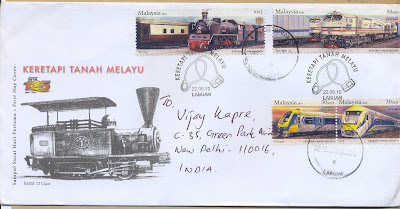

The First Day Cover on the left celebrates the
Melodi Grand Prix (
MGP or
Grand Prix) which is an annual music competition organised by Norwegian public broadcaster Norsk Rikskringkasting (NRK). It determines the country's representatives for the
Eurovision Song Contest, and has been staged almost every year since 1960. The festival has produced three Eurovision winners and nine top-five placings for Norway at the contest. However, Norway holds the record for the number of entries who have come last since entering Eurovision; 10 in all. Despite this, the competition still makes considerable impact on music charts in Norway, and in other Nordic countries, with the 2008 winner topping the Norwegian charts, as well as peaking 8th on the Swedish charts.
The FDC on the right commemorates the national anthem - Ja, vi elsker dette landet (In English it would be:
"Yes, we love this country") is the
national anthem of Norway. It is commonly referred to as just "Ja, vi elsker" ("Yes, we love"). The lyrics were written by
Bjørnstjerne Bjørnson between 1859 and 1868, and the melody was written by his cousin
Rikard Nordraak in 1864. It was first performed publicly on 17 May 1864 in connection with the
50th anniversary of the constitution. Usually only the first and the last two verses are sung. It would be quite appropriate here to mention a few controversies in connection with the anthem. In
1905 the
Union between
Sweden and Norway was
dissolved after many years of Norwegian struggle for equality between the two states, as stipulated in the 1815 Act of Union. The unilateral declaration by the Norwegian Storting of the union's dissolution on 7
th June provoked strong Swedish reactions, bringing the two nations to the brink of war in the autumn. In Sweden, pro-war conservatives were opposed by the Social Democrats, whose leaders Hjalmar Branting and Zeth Höglund spoke out for reconciliation and a peaceful settlement with Norway. Swedish socialists sang
Ja, vi elsker dette landet to demonstrate their support for the Norwegian people’s right to secede from the union.
During World War II, the anthem was used
both by the Norwegian resistance and the Nazi collaborators, the latter group mainly for propaganda reasons. Eventually, the German occupiers officially forbade any use of the anthem.
In May 2006, the multicultural newspaper
Utrop proposed that the
national anthem be translated into Urdu, the native language of the most numerous group of recent immigrants to Norway. The editor's idea was that people from other ethnic groups should be able to honour their adopted country with devotion, even if they were not fluent in Norwegian. This proposal was referred to by other more widely read papers, and
a member of the Storting called the proposal "integration in reverse". One proponent of translating the anthem received batches of hate-mail calling her a traitor and
threatening her with decapitation.
These two lovely covers were sent to me by
Sissel.










